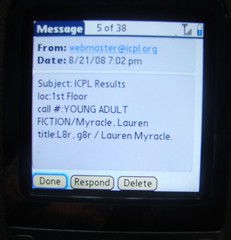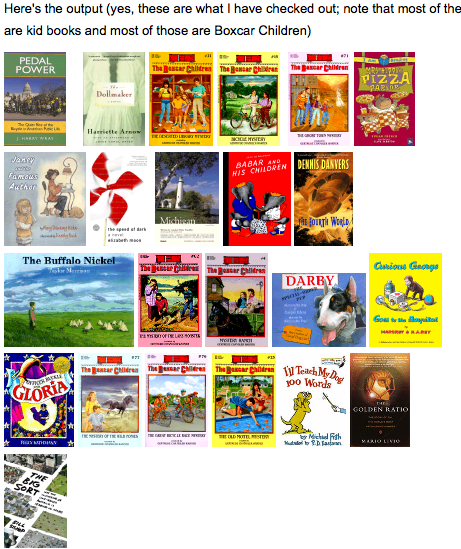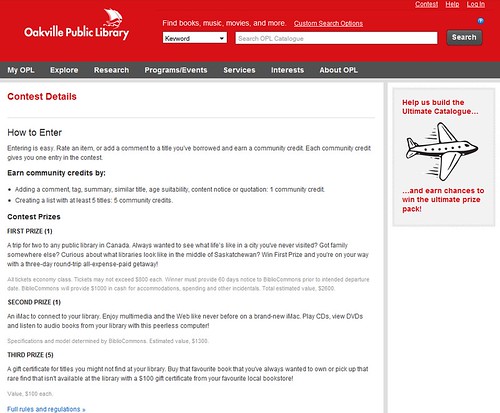Last week, I highlighted Ed Vielmetti’s thoughts about adding covers to the list of overdue books you have checked out, as well as the ability to text the location of an item to your cell phone. Both of these are enhancements that I, as Patron 2.0, would very much appreciate my library providing.
In the comments on that post, Jason from the Iowa City Public Library gave us a working example (working in an Innovative catalog, at least). I tried it out and sure enough, a few seconds after entering my cell phone number, up popped a text message with the location of the item.Very slick, and very useful.

Even better, Ed came back into the comments on that post and pointed at the script that runs this service. It was originally written by Adam from Bryn Mawr more than a year ago, where it’s still in place today. Not only is it freely available online, but there are very clear directions for sending SMS from a III catalog (thanks, Adam!).

If you have a programmer on staff or someone who knows just enough to be dangerous, now you, too, can implement this service at no cost to your library to make your catalog that much more useful.
iowa city public library,
library 2.0,
opac 2.0,
sms,
text messaging
As always, Ed Vielmetti is thinking about how to make the library’s data work harder for him, with or without the library’s help. (Of course, Ed’s library is the phenomenal Ann Arbor District Library, which already offers more web-based services than most other libraries, but the simple openness of their systems makes it easy for a superpatron like Ed to extend these services even further on his own.)
So when Ed couldn’t find some overdue library books in the house, he started wondering aloud how the library services could help him out. Now we just need to think like Ed, too.
Now Where Did I Put that Book?
“All of the library books I have are tagged with RFID chips, which is used for inventory control. That should mean that I can use something like this 3M RFID locator device as a reader and scanner to locate a lost item.”
Wall of Books Revisited: Just What Do I Have Checked Out?
“No, I still haven’t found my overdue books, but at least now I know what they look like.
The AADL prints a helpful list of the books you have checked out, but doesn’t give you pictures of them (not yet at least). So I’m working on the Greasemonkey script that will insert cover images into that page. This is not that, but a step along the way.”

What I’m really waiting for, though, is Ed’s Greasemonkey script that adds “text me the location of this item” to a library catalog viewed in Firefox. I don’t think I’ll be able to use it for my home library’s catalog, but I’ll hold out hope it can be adapted.
Text Me the Location of this Book - Step One of a Greasemonkey Plugin for the AADL
“At the time I noted “how hard could it be to add this to my own library with Greasemonkey” or some similar off the cuff remark (oh how foolish I can be some times). So let’s pick that apart and see how I’d do this at the AADL.”
book covers,
ed vielmetti,
opac 2.0,
overdue books,
superpatron,
wall of covers
I blogged about Beth Jefferson’s Bibliocommons project last year, impressed with her goal of creating a library catalog interface from scratch that is focused on users and integrates community and social pieces around the content, rather than tacking them on here and there. I also showed some screenshots of the beta version in a presentation I did at Computers in Libraries this past spring in an attempt to highlight how things like reviews, tagging, and community could actually work in a library catalog if they weren’t an afterthought.
So it’s with great excitement that I read in Library Journal that the first installation of Bibliocommons is now live as the OPAC for the Oakville, Ontario, library in Canada. There is much to explore here, and I need to get in and see if anything has changed since the beta, but my favorite part is still the catalog home page that shows actual users on it.

As I noted in my CiL talk, it’s refreshing just to see a catalog I could log in to with a username instead of a barcode - what a novel idea! Don’t even get me started on the fact that the interface includes terms like “connect,” “network,” and “trusted sources.” So much good stuff here, though - ratings, tags, lists, users, comments, recommendations, faceted browsing, contextual help, natural language (not jargon), user-based age ratings, “share with a friend” links, similar titles, a shelf browser with cover images, and the ability to get rewards for adding content to the catalog. I love that I didn’t have to dig deeply into the catalog to start finding user-generated content, as I often have to do in other OPACs when I need an example.

There’s even a contest right now to help them gather feedback from users (with an awesome twist on the prize), not that they need this based on the beta, where users contributed far more content than anticipated.

There are more screenshots available here, but I can’t encourage you strongly enough to just go play with this catalog on your own to see just how different it is from yours. Even better, this interface can run over any vendor’s system, so adoption isn’t limited and libraries don’t have to start over from scratch.
I will definitely continue following Bibliocommons closely, and I hope Beth will be able to give a few more talks or write more articles about the project to keep us update to date on usage of this great new product. Congratulations to Beth and her team for getting a solid product with lots of potential out the door, and kudos to the Oakville Public Library folks for implementing it. This is definitely one to watch, and I know I’ll be posting more about it in the future.
bibliocommons,
oakville public library,
opac 2.0
Last year, I noted how the Topeka and Shawnee County Public Library and others analyzed the user experience in the catalog and began using MeeboMe as a way to provide a path out of the “no results” dead end. Now we have another great example from the Allen County Public Library of re-examining dead ends in the catalog
Hi-Tech Hi-Touch: A Sirsi Patron Material Request Form
“The point of need that interested me was to make a material request form available for the patron when they could not find their search item….
The real meat of the processing is handled by the findit.php code. This is a reentrant form that does all the validation and processing. If you would like a copy of the code just email and I will send it to you.” [ACPL’s Innovation through Technology]

So basically, Sean Robinson at ACPL added a purchase request form to the search results page of the catalog so that if the Library doesn’t own the title the patron is looking for, she can immediately submit a purchase request. It’s these seemingly minor improvements that provide a more robust service in a place patrons don’t normally find a librarian. Why our vendors can’t think of these things is beyond me, but it’s great to see librarians like Sean taking the initiative to implement them.
allen county public library,
opac 2.0,
sean robinson
Sunday afternoon, we drove to Flint to see the Flint Young People’s Ballet Theatre adaptations of Snow White and Little Women. The Snow White adaptation was done very well, the dwarves being especially amusing. The Little Women adaptation was very slow in places and we often felt we were simply watching ballerinas standing or sitting and doing nothing in particular. So, I’m not so sure Alcott’s story is suitable into translation as dance. We did think all of the dancers did a really fine job and Sarah especially watched for tips on how to improve her own techniques. A word of caution if you go to the University of Michigan Flint Theater on a Sunday, parking is in the open lot down the street — not in the nearby parking garages (we drove around in circles for about 15 minutes to figure this out) and it is free even though you must pull out a ticket to open the gate.
The story of Snow White is thought to have been first published in a collection of folk tales between 1812 and 1815 by the Brothers Grimm and first published in English in 1823. Why seven dwarves? Because the number 7 was considered a magical number, think of all the 7’s in the Bible. Disney’s Snow White movie came out Christmas 1937 and was the first feature length cartoon. This movie had a profound impact on me. There was a little white church on a road we drove by often when I was a child and I insisted that it was really Snow White’s house.
Jacob and Wilhelm Grimm were born 1785 and 1786 in Germany. Jacob was 11 when their father died and three years later they were sent to live with an Aunt. Possibly the source of their fascination with wicked caretakers? They became librarians in 1808 when their mother died, providing for their younger siblings. By 1812 Children and Household Tales was published — a collection of folk tales. The first of many librarians to provide the world of children’s literature with its best books. Wilhelm died in 1859 and Jacob in 1863.
Lousia May Alcott wrote Little Women in 1868. It always bothers me when I read that Little Women was simply based upon Alcott’s own experiences growing up. It implies that the story is autobiographical in nature and until recently, I thought it was. But the truth is, Alcott just used what she knew from her life, her sisters and her parents to create a fictional story, no differently than any other fiction writer. There are important differences between her real life story and the one she created in Little Women.
In one of my other posts (Literary Musings) you will see mention of a book (Susan Cheever’s American Bloomsbury) that details Alcott’s experiences growing up in Concord, Massachussetts with Ralph Waldo Emerson, Henry Thoreau, Nathaniel Hawthorne, Herman Melville. Alcott grew up very poor and this in turn motivated her to write, to try to support her family herself.
Louisa’s father Amos Bronson Alcott was a transcendentalist philosopher and education reformer and moved his family to Concord to live on Emerson’s property after his Temple School failed. He did not serve in the Civil War. Abigail was his wife. Henry David Thoreau also lived there and became one of Louisa’s teachers and he is the person she modelled her character Laurie after. Thoreau never married and died in 1862.
Louisa too never married. She was not even that young during the Civil War, her birth year being 1832. In 1858 the Alcotts moved to Orchard House and it is there she wrote Little Women. During the Civil War, Louisa served as a nurse in Washington, DC. She had to get special permission to do this as she was a single woman. There she became ill and never fully recovered. During her years after, she was treated with mercury and this poison ended her life in 1888, just two days after her father died. She is buried in the Sleepy Hollow Cemetery in Concord.
Bronson and Abigail had four daughters: Anna, Louisa, Elizabeth and May. Meg was modelled after Anna. Anna didn’t marry until 1860 and it was her wedding that was fictionalized in the book. In 1877 with Louisa’s help, she bought the Thoreau house in Concord.
Beth was modelled after Elizabeth, but Elizabeth was not the youngest daughter. She was born in 1835 and died in 1856. She did contract scarlet fever from a poor family her mother was caring for, and recovered. Two years later, she died.
Amy was modelled after May. May was a prolific artist and studied art in Europe with funds from Louisa. Louisa published her first book Flower Fables in 1854 and was able to provide for her family like her father never had been. May married in Europe then died soon after giving birth. Her daughter named Louisa was raised by her Aunt Louisa.
Louisa May Alcott was a successful children’s book author and was adept at translating her life experiences into deeply moving fictional stories. We do her a disservice when we present Little Women as nothing more than a re-write of her life.


















